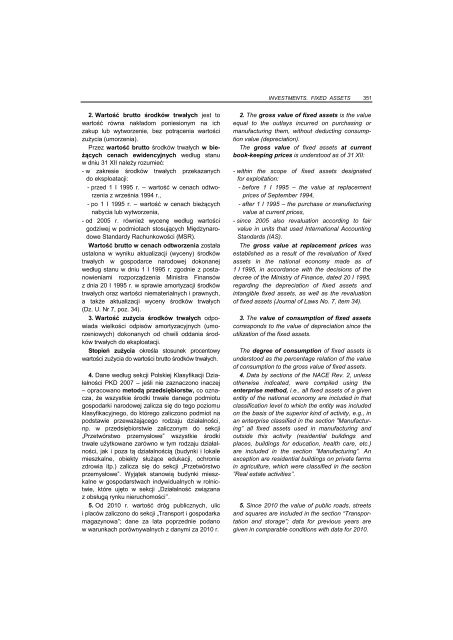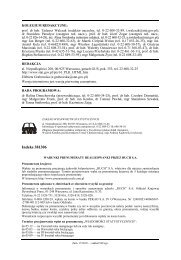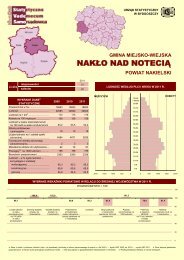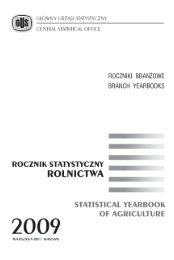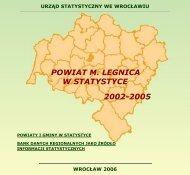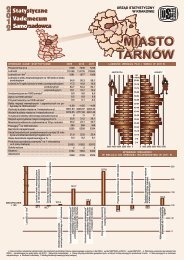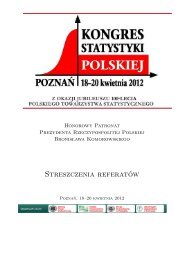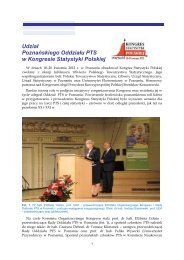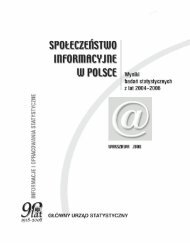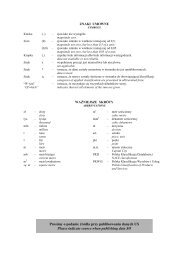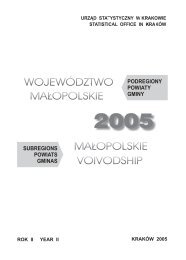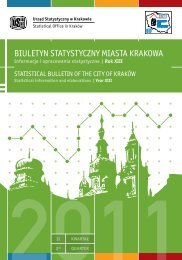Untitled - Główny Urząd Statystyczny
Untitled - Główny Urząd Statystyczny
Untitled - Główny Urząd Statystyczny
You also want an ePaper? Increase the reach of your titles
YUMPU automatically turns print PDFs into web optimized ePapers that Google loves.
2. Wartość brutto środków trwałych jest to<br />
wartość równa nakładom poniesionym na ich<br />
zakup lub wytworzenie, bez potrącenia wartości<br />
zużycia (umorzenia).<br />
Przez wartość brutto środków trwałych w bieżących<br />
cenach ewidencyjnych według stanu<br />
w dniu 31 XII należy rozumieć:<br />
- w zakresie środków trwałych przekazanych<br />
do eksploatacji:<br />
- przed 1 I 1995 r. – wartość w cenach odtworzenia<br />
z września 1994 r.,<br />
- po 1 I 1995 r. – wartość w cenach bieżących<br />
nabycia lub wytworzenia,<br />
- od 2005 r. również wycenę według wartości<br />
godziwej w podmiotach stosujących Międzynarodowe<br />
Standardy Rachunkowości (MSR).<br />
Wartość brutto w cenach odtworzenia została<br />
ustalona w wyniku aktualizacji (wyceny) środków<br />
trwałych w gospodarce narodowej dokonanej<br />
według stanu w dniu 1 I 1995 r. zgodnie z postanowieniami<br />
rozporządzenia Ministra Finansów<br />
z dnia 20 I 1995 r. w sprawie amortyzacji środków<br />
trwałych oraz wartości niematerialnych i prawnych,<br />
a także aktualizacji wyceny środków trwałych<br />
(Dz. U. Nr 7, poz. 34).<br />
3. Wartość zużycia środków trwałych odpowiada<br />
wielkości odpisów amortyzacyjnych (umorzeniowych)<br />
dokonanych od chwili oddania środków<br />
trwałych do eksploatacji.<br />
Stopień zużycia określa stosunek procentowy<br />
wartości zużycia do wartości brutto środków trwałych.<br />
4. Dane według sekcji Polskiej Klasyfikacji Działalności<br />
PKD 2007 – jeśli nie zaznaczono inaczej<br />
– opracowano metodą przedsiębiorstw, co oznacza,<br />
że wszystkie środki trwałe danego podmiotu<br />
gospodarki narodowej zalicza się do tego poziomu<br />
klasyfikacyjnego, do którego zaliczono podmiot na<br />
podstawie przeważającego rodzaju działalności,<br />
np. w przedsiębiorstwie zaliczonym do sekcji<br />
„Przetwórstwo przemysłowe” wszystkie środki<br />
trwałe użytkowane zarówno w tym rodzaju działalności,<br />
jak i poza tą działalnością (budynki i lokale<br />
mieszkalne, obiekty służące edukacji, ochronie<br />
zdrowia itp.) zalicza się do sekcji „Przetwórstwo<br />
przemysłowe”. Wyjątek stanowią budynki mieszkalne<br />
w gospodarstwach indywidualnych w rolnictwie,<br />
które ujęto w sekcji „Działalność związana<br />
z obsługą rynku nieruchomości’’.<br />
5. Od 2010 r. wartość dróg publicznych, ulic<br />
i placów zaliczono do sekcji „Transport i gospodarka<br />
magazynowa”; dane za lata poprzednie podano<br />
w warunkach porównywalnych z danymi za 2010 r.<br />
INVESTMENTS. FIXED ASSETS<br />
351<br />
2. The gross value of fixed assets is the value<br />
equal to the outlays incurred on purchasing or<br />
manufacturing them, without deducting consumption<br />
value (depreciation).<br />
The gross value of fixed assets at current<br />
book-keeping prices is understood as of 31 XII:<br />
- within the scope of fixed assets designated<br />
for exploitation:<br />
- before 1 I 1995 – the value at replacement<br />
prices of September 1994,<br />
- after 1 I 1995 – the purchase or manufacturing<br />
value at current prices,<br />
- since 2005 also revaluation according to fair<br />
value in units that used International Accounting<br />
Standards (IAS).<br />
The gross value at replacement prices was<br />
established as a result of the revaluation of fixed<br />
assets in the national economy made as of<br />
1 I 1995, in accordance with the decisions of the<br />
decree of the Ministry of Finance, dated 20 I 1995,<br />
regarding the depreciation of fixed assets and<br />
intangible fixed assets, as well as the revaluation<br />
of fixed assets (Journal of Laws No. 7, item 34).<br />
3. The value of consumption of fixed assets<br />
corresponds to the value of depreciation since the<br />
utilization of the fixed assets.<br />
The degree of consumption of fixed assets is<br />
understood as the percentage relation of the value<br />
of consumption to the gross value of fixed assets.<br />
4. Data by sections of the NACE Rev. 2, unless<br />
otherwise indicated, were compiled using the<br />
enterprise method, i.e., all fixed assets of a given<br />
entity of the national economy are included in that<br />
classification level to which the entity was included<br />
on the basis of the superior kind of activity, e.g., in<br />
an enterprise classified in the section ”Manufacturing”<br />
all fixed assets used in manufacturing and<br />
outside this activity (residential buildings and<br />
places, buildings for education, health care, etc.)<br />
are included in the section ”Manufacturing”. An<br />
exception are residential buildings on private farms<br />
in agriculture, which were classified in the section<br />
”Real estate activities’’.<br />
5. Since 2010 the value of public roads, streets<br />
and squares are included in the section “Transportation<br />
and storage”; data for previous years are<br />
given in comparable conditions with data for 2010.


